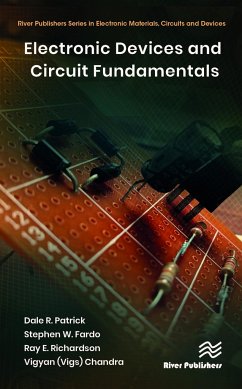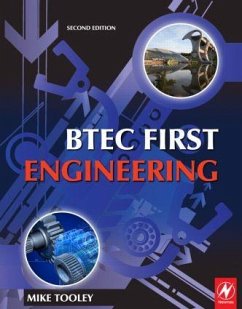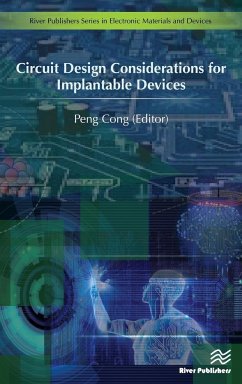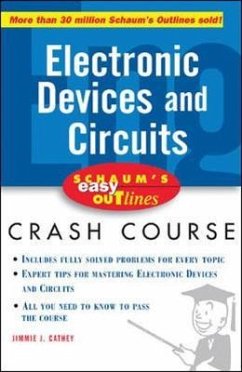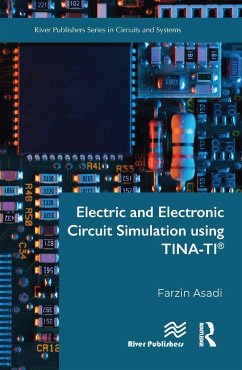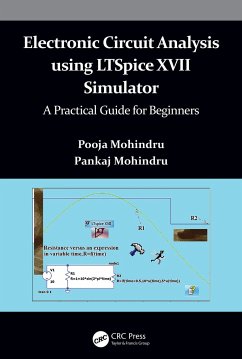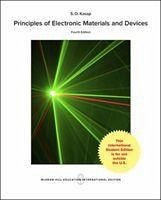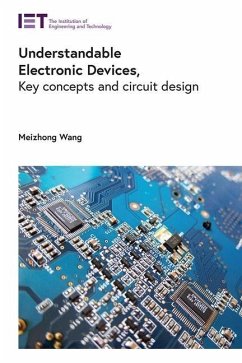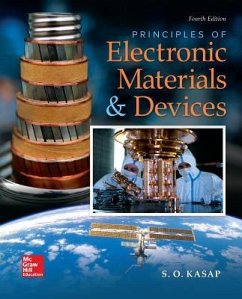
Electronic Devices and Circuit Theory
Pearson New International Edition

PAYBACK Punkte
68 °P sammeln!
For upper-level courses in Devices and Circuits at 2-year or 4-year Engineering and Technology institutes.
Electronic Devices and Circuit Theory, Eleventh Edition, offers students a complete, comprehensive survey, focusing on all the essentials they will need to succeed on the job. Setting the standard for nearly 30 years, this highly accurate text is supported by strong pedagogy and content that is ideal for new students of this rapidly changing field. The colorful layout with ample photographs and examples enhances students’ understanding of important topics. This text is an excellent reference work for anyone involved with electronic devices and other circuitry applications, such as electrical and technical engineers.
Features + Benefits
For upper-level courses in Devices and Circuits at 2-year or 4-year Engineering and Technology institutes.
Electronic Devices and Circuit Theory, Eleventh Edition, offers students a complete, comprehensive survey, focusing on all the essentials they will need to succeed on the job. Setting the standard for nearly 30 years, this highly accurate text is supported by strong pedagogy and content that is ideal for new students of this rapidly changing field. The colorful layout with ample photographs and examples enhances students’ understanding of important topics. This text is an excellent reference work for anyone involved with electronic devices and other circuitry applications, such as electrical and technical engineers.
Hallmark Features:
Using a systems approach, this edition represents an exhaustive effort to enhance the material that introduces the concept of system engineering.
For ac analysis, the text emphasizes the difference between the no-load and loaded gain, including examples of how each affects the gain and characteristics of a system.
Entire sections remain to demonstrate the impact of the source and load resistance on the system response, although now the material is an integral part of the ac analysis chapter of the device under discussion.
The text’s visual presentationrepresents a concerted effort to ensure that important statements and conclusions stand out in boldface and/or color.
Color is used for instructional purposes wherever appropriate to identify important parameters, network regions, and results, as well as to enhance students’ understanding of figures.
This approach improves readability. Summaries and equation lists appear near the end of each chapter for review and study.
Practical applications in every chapter cover the latest in the industry.
There are more than 100 practical applications at the end of each chapter, helping students learn how theory is applied in real-world settings.
The computer coverage extends beyond what you'll find in competing texts.
The latest versions of PSpice, Multisim, and Mathcad are covered in specific sections throughout the text, including descriptions of important differences in the application of each software package.
PSpice and Multisim are both covered in an effort to ensure students are familiar with software packages they might use in future studies or the real world, or both.
Circuit files are provided to enhance students’ learning experience.
Selected circuit diagrams in the text are rendered in Multisim 2001, Multisim 7, and PSpice 9.2 and these circuit files are provided on the book's CD-ROM and for quick, easy download at the book's companion website (www.prenhall.com/boylestad ).
Multisim and PSpice are widely regarded as excellent simulation tools for classroom and laboratory learning but students don't necessarily have to use these circuit files with this textbook.
Circuits created in later more current releases of Multisim and PSpice may also be available at the companion website.
Companion website available at www.prenhall.com/boylestad
The companion site contains Multisim and PSpice circuit files, chapter summary reviews, and additional multiple choice questions, providing students with an interactive resource that brings the subject matter to life.
1. Semiconductor Diodes.
2. Diode Applications.
3. Bipolar Junction Transistors.
4. DC Biasing—BJTs.
5. BJT AC Analysis
6. Field Effect Transistors
7. FET Biasing.
8. FET Amplifiers.
9. BJT and JFET Frequency Response.
10. Operational Amplifiers.
11. Op-Amp Applications.
12. Power Amplifiers.
13. Linear-Digital ICs.
14. Feedback and Oscillator Circuits.
15. Power Supplies (Voltage Regulators).
16. Other Two-Terminal Devices.
17. pnpn and Other Devices.
Electronic Devices and Circuit Theory, Eleventh Edition, offers students a complete, comprehensive survey, focusing on all the essentials they will need to succeed on the job. Setting the standard for nearly 30 years, this highly accurate text is supported by strong pedagogy and content that is ideal for new students of this rapidly changing field. The colorful layout with ample photographs and examples enhances students’ understanding of important topics. This text is an excellent reference work for anyone involved with electronic devices and other circuitry applications, such as electrical and technical engineers.
Features + Benefits
For upper-level courses in Devices and Circuits at 2-year or 4-year Engineering and Technology institutes.
Electronic Devices and Circuit Theory, Eleventh Edition, offers students a complete, comprehensive survey, focusing on all the essentials they will need to succeed on the job. Setting the standard for nearly 30 years, this highly accurate text is supported by strong pedagogy and content that is ideal for new students of this rapidly changing field. The colorful layout with ample photographs and examples enhances students’ understanding of important topics. This text is an excellent reference work for anyone involved with electronic devices and other circuitry applications, such as electrical and technical engineers.
Hallmark Features:
Using a systems approach, this edition represents an exhaustive effort to enhance the material that introduces the concept of system engineering.
For ac analysis, the text emphasizes the difference between the no-load and loaded gain, including examples of how each affects the gain and characteristics of a system.
Entire sections remain to demonstrate the impact of the source and load resistance on the system response, although now the material is an integral part of the ac analysis chapter of the device under discussion.
The text’s visual presentationrepresents a concerted effort to ensure that important statements and conclusions stand out in boldface and/or color.
Color is used for instructional purposes wherever appropriate to identify important parameters, network regions, and results, as well as to enhance students’ understanding of figures.
This approach improves readability. Summaries and equation lists appear near the end of each chapter for review and study.
Practical applications in every chapter cover the latest in the industry.
There are more than 100 practical applications at the end of each chapter, helping students learn how theory is applied in real-world settings.
The computer coverage extends beyond what you'll find in competing texts.
The latest versions of PSpice, Multisim, and Mathcad are covered in specific sections throughout the text, including descriptions of important differences in the application of each software package.
PSpice and Multisim are both covered in an effort to ensure students are familiar with software packages they might use in future studies or the real world, or both.
Circuit files are provided to enhance students’ learning experience.
Selected circuit diagrams in the text are rendered in Multisim 2001, Multisim 7, and PSpice 9.2 and these circuit files are provided on the book's CD-ROM and for quick, easy download at the book's companion website (www.prenhall.com/boylestad ).
Multisim and PSpice are widely regarded as excellent simulation tools for classroom and laboratory learning but students don't necessarily have to use these circuit files with this textbook.
Circuits created in later more current releases of Multisim and PSpice may also be available at the companion website.
Companion website available at www.prenhall.com/boylestad
The companion site contains Multisim and PSpice circuit files, chapter summary reviews, and additional multiple choice questions, providing students with an interactive resource that brings the subject matter to life.
1. Semiconductor Diodes.
2. Diode Applications.
3. Bipolar Junction Transistors.
4. DC Biasing—BJTs.
5. BJT AC Analysis
6. Field Effect Transistors
7. FET Biasing.
8. FET Amplifiers.
9. BJT and JFET Frequency Response.
10. Operational Amplifiers.
11. Op-Amp Applications.
12. Power Amplifiers.
13. Linear-Digital ICs.
14. Feedback and Oscillator Circuits.
15. Power Supplies (Voltage Regulators).
16. Other Two-Terminal Devices.
17. pnpn and Other Devices.
For upper-level courses in Devices and Circuits at 2-year or 4-year Engineering and Technology institutes. Electronic Devices and Circuit Theory, Eleventh Edition, offers students a complete, comprehensive survey, focusing on all the essentials they will need to succeed on the job. Setting the standard for nearly 30 years, this highly accurate text is supported by strong pedagogy and content that is ideal for new students of this rapidly changing field. The colorful layout with ample photographs and examples enhances students' understanding of important topics. This text is an excellent reference work for anyone involved with electronic devices and other circuitry applications, such as electrical and technical engineers.
Dieser Artikel kann nur an eine deutsche Lieferadresse ausgeliefert werden.




